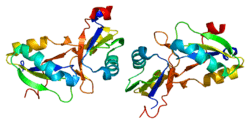Nucleoporin 35
Nucleoporin 35 (Nup35) is a protein that in humans is encoded by the NUP35 gene.[5]
Background
This gene encodes a member of the nucleoporin family. The protein is localized to the nuclear rim and is part of the nuclear pore complex (NPC). All molecules entering or leaving the nucleus either diffuse through or are actively transported by the NPC.[5]
References
Further reading
- Rodenas E, Klerkx EP, Ayuso C, Audhya A, Askjaer P (2009). "Early embryonic requirement for nucleoporin Nup35/NPP-19 in nuclear assembly". Developmental Biology. 327 (2): 399–409. doi:10.1016/j.ydbio.2008.12.024. PMID 19146848.
- Olsen JV, Blagoev B, Gnad F, et al. (2006). "Global, in vivo, and site-specific phosphorylation dynamics in signaling networks". Cell. 127 (3): 635–48. doi:10.1016/j.cell.2006.09.026. PMID 17081983.
- Beausoleil SA, Villén J, Gerber SA, et al. (2006). "A probability-based approach for high-throughput protein phosphorylation analysis and site localization". Nat. Biotechnol. 24 (10): 1285–92. doi:10.1038/nbt1240. PMID 16964243.
- Mansfeld J, Güttinger S, Hawryluk-Gara LA, et al. (2006). "The conserved transmembrane nucleoporin NDC1 is required for nuclear pore complex assembly in vertebrate cells". Mol. Cell. 22 (1): 93–103. doi:10.1016/j.molcel.2006.02.015. PMID 16600873.
- Hillier LW, Graves TA, Fulton RS, et al. (2005). "Generation and annotation of the DNA sequences of human chromosomes 2 and 4". Nature. 434 (7034): 724–31. doi:10.1038/nature03466. PMID 15815621.
- Hawryluk-Gara LA, Shibuya EK, Wozniak RW (2005). "Vertebrate Nup53 Interacts with the Nuclear Lamina and Is Required for the Assembly of a Nup93-containing Complex". Mol. Biol. Cell. 16 (5): 2382–94. doi:10.1091/mbc.E04-10-0857. PMC 1087243. PMID 15703211.
- Gerhard DS, Wagner L, Feingold EA, et al. (2004). "The Status, Quality, and Expansion of the NIH Full-Length cDNA Project: The Mammalian Gene Collection (MGC)". Genome Res. 14 (10B): 2121–7. doi:10.1101/gr.2596504. PMC 528928. PMID 15489334.
- Strausberg RL, Feingold EA, Grouse LH, et al. (2003). "Generation and initial analysis of more than 15,000 full-length human and mouse cDNA sequences". Proc. Natl. Acad. Sci. U.S.A. 99 (26): 16899–903. doi:10.1073/pnas.242603899. PMC 139241. PMID 12477932.
- Cronshaw JM, Krutchinsky AN, Zhang W, et al. (2002). "Proteomic analysis of the mammalian nuclear pore complex". J. Cell Biol. 158 (5): 915–27. doi:10.1083/jcb.200206106. PMC 2173148. PMID 12196509.
This article is issued from
Wikipedia.
The text is licensed under Creative Commons - Attribution - Sharealike.
Additional terms may apply for the media files.





